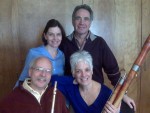Title
Works of varied styles in unusual combinations make up the program for a faculty recital on Wednesday evening, April 29, for which I will be joining flutist Robert Langevin, bassoonist Judith LeClair, and harpist Nancy Allen.
Body
The program will begin with the Sonate en Concert for flute and piano by Jean-Michel Damase, who was born in 1928 to a musical family in Bordeaux. He began composing at an early age and was unanimously awarded first prize in piano from the Paris Conservatory when he was 11. Many other awards followed, including first prize in composition from the conservatory and, at just 19, the Prix de Rome. This piece, written in 1952, is based on the early Baroque suite with many dance-like movements. Damase’s modern approach to this music, with jazzy chordal support and lots of technical display for the flute, shows his respect for tradition and form yet gives it a playful and surprising twist.
Next we offer the Interférences I for Bassoon and Piano by Roger Boutry. Another product of the Paris Conservatory, Boutry was born in 1932 and studied with Nadia Boulanger and Marguerite Long. In 1954 he also won the Prix de Rome. His professional life is divided between conducting, composing, and teaching. He has been professor of harmony at the Paris Conservatory, conductor and musical director of the Garde Republicaine (the ceremonial unit of the French Gendarmerie), and is known as a first-rate pianist with a varied and unusual repertoire. As a composer, he is regarded for his musical versatility in many genres. This work, written for noted French bassoonist Maurice Allard, shows the breadth and scope of the instrument. It is written in a highly improvisational style, with an opening displaying wails of great intensity followed by rhythmic fits and jerks. The closing Allegro is filled with manic urgency and biting articulation, punctuated with heartfelt cries of pained chromaticisms. This work is an emotional and technical tour-de-force.
To end the first half, Nancy joins Judy and Robert in a performance of Maurice Ravel’s Sonatine, originally written for solo piano, composed for a competition sponsored by a magazine that went out of business. Ravel was the only entrant. The work is dedicated to Ida and Cipa Godebski; Ravel later dedicated his Mother Goose Suite to their children. This arrangement, written for harp, flute, and cello (but we’ll be using a bassoon, instead), is by noted Spanish harpist Carlos Salzedo, who studied at the Paris Conservatory and later served on the faculty of New York’s Institute of Musical Art (forerunner of The Juilliard School). Apparently, when Salzedo showed his transcription to his dear composer friend, Ravel was delighted with it.
Our second half starts with a haunting work by Bernard Andres, who was born in 1941 in Belfort, a small town in northeastern France. He pursued harp studies at the Paris Conservatory and although he was rather successful as a professional performer, the mysteries and challenges of composition won out. His early works enchanted his audiences by fusing fresh contemporary sounds with atonal melodic tensions. This piece, titled Chants d’arrière-saison (Songs of Last Season), was originally written for horn and harp, but has been re-edited for both cello and bassoon by the composer. It comprises seven relatively short movements, which are extremely descriptive in nature. All are character pieces that show the fabulous emotional range of the human voice, so beautifully captured by the mournful sound of the bassoon. The harp offers a rich array of imaginative devices, notably the use of harmonics and glissandos as well as knocking upon the wooden frame—all helping to set special moods and colors. It is truly a magical experience.
Quatre Pièces Pour Flute et Piano, Op. 10, by Canadian composer Jacques Hétu, follows. Hétu studied with the late Lukas Foss, and in Paris with Henri Dutilleux and Olivier Messiaen (at the Paris Conservatory). His own musical language combines modality and dissonance with expressiveness and forcefulness. This work, written in the 12-tone system, is especially noted for its percussive rhythms and harmonic tension.
Judy will join Robert and me to finish the program with the Grand Trio for Two Flutes and Piano in G Major, Op. 119, by Friedrich Kuhlau. He was born in 1786 in the small town of Lüneburg, Germany, where he studied piano, flute, and other instruments. As one of the greatest of the early flute composers, he proudly earned the title “the Beethoven of the flute.” When I was a young piano student, I was given several of his Sonatinas to learn and was struck by the melodious and virtuosic piano writing. I still love these early pieces. It was a pleasure to reignite that love through this trio. In this arrangement for flute and bassoon, there is much bravura writing for all three instruments. It is a three-movement work showing some fancy scale passagework, lyrical tunes, and a great joyful spirit, all ending in a boisterous rondo.
We are so looking forward to sharing these wonderful works with you.





